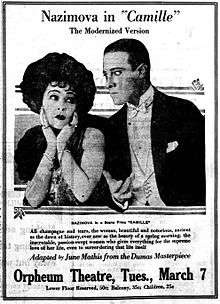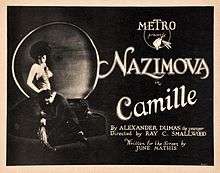Camille (1921 film)
Camille is a 1921 American silent drama film starring Alla Nazimova as Marguerite and Rudolph Valentino as her lover, Armand. It is based on the play adaptation La Dame aux Camélias (The Lady of the Camellias) by Alexandre Dumas, fils, which was first published in French as a novel in 1848 and as a play in 1852. Camille is one of numerous screen adaptations of Dumas, fils' story.[1][2] The film was set in 1920s Paris, whereas the original version took place in Paris in the 1840s. It had lavish Art Deco sets and Rudolph Valentino later married the film's art director, Natacha Rambova.
| Camille | |
|---|---|
 Newspaper ad from March 1922 in the Coconino Sun (Flagstaff, Arizona) in the Library of Congress | |
| Directed by | Ray C. Smallwood |
| Produced by | Alla Nazimova |
| Written by | June Mathis (scenario) |
| Based on | La Dame aux Camélias by Alexandre Dumas, fils |
| Starring | Alla Nazimova Rudolph Valentino Rex Cherryman Arthur Hoyt Patsy Ruth Miller |
| Cinematography | Rudolph J. Bergquist |
Production company | Nazimova Productions |
| Distributed by | Metro Pictures Corporation |
Release date |
|
Running time | 70 minutes (contemporary edit) |
| Country | United States |
| Language | Silent (English intertitles) |
Plot
A young law student, Armand (Rudolph Valentino) becomes smitten with a courtesan, Marguerite (Alla Nazimova). Marguerite is constantly surrounded by suitors, whom she entertains at her lavish apartment. She also has consumption and is frequently beset by bouts of illness.
Armand sees Marguerite at the opera and, later, pursues her when he attends one of her private parties. She rejects his advances at first, but eventually returns his affection.
The two live happily together until Armand's father, seeking to protect his family's reputation, convinces Marguerite to end the relationship. She finally relents and runs away to a wealthy client, leaving a note for Armand.
When Armand finds the note he is shattered. The sorrow eventually turns to rage, and he decides to plunge into Parisian nightlife, associating himself with Olympe, another courtesan. When he sees Marguerite at a casino, he publicly denounces her.
Marguerite gives up her life as a courtesan and quickly finds herself in massive debt. Her illness also takes a heavy toll. Eventually, as she lies dying in bed, her furniture and belongings are repossessed. She persuades the men taking her belongings to allow her to keep her most precious possession: a book - Manon Lescaut - Armand gave to her.
Marguerite dies lying in bed in her apartment holding the book Armand gave her, wishing to sleep where she is happy dreaming about Armand. Marguerite's maid Nanine, and her newlywed friends Gaston and Nichette are at her bedside as she dies. Unlike the original novel, the film does not depict Armand and Marguerite ever seeing each other again after the casino scene and offers no suggestion that Armand ever learned of Marguerite's sacrifice and true feelings for him.
Cast
- Rudolph Valentino as Armand Duval
- Alla Nazimova as Marguerite Gautier
- Rex Cherryman as Gaston Rieux
- Arthur Hoyt as Count de Varville
- Zeffie Tilbury as Prudence
- Patsy Ruth Miller as Nichette
- Elinor Oliver as Nanine, Marguerite's Maid
- William Orlamond as Monsieur Duval, Armand's Father
- Consuelo Flowerton as Olympe
- Edward Connelly as The Duke (uncredited)

Reception
Picture-Play Magazine wrote of the film in their August 1921 issue: "The Camille and Armand of tradition are forgotten in the potent lure of the modern characterization of Nazimova and Rudolph Valentino. Bizarre, ephemeral, at moments, and at others, frenzied, their version promises a haunting succession of mesmeric pictures. It does not aim to present the Camille that successive generations have applauded and sniffled over. Because it is Nazimova's presentation of a story that has survived even the buffetings of endless productions—good, bad, and indifferent—it promises to be interesting."[3]
Preservation
The film has survived and has been made available to the public on DVD and VHS by various film distributors and independent dealers. It is presented as a bonus on the DVD copy of the 1936 version Camille with Greta Garbo.
References
- AFI (n.d.), "Camille", The AFI Catalog of Feature Films, American Film Institute, retrieved 29 July 2016
- silentera.com (8 March 2011), "Progressive Silent Film List: Camille (1921)", SilentEra.com, retrieved 29 July 2016
- "Camille". Picture-Play Magazine. 14: 76. August 1921. Retrieved 18 August 2015.
External links
| Wikimedia Commons has media related to Camille (1921 film). |
- Camille on IMDb
- Synopsis at AllMovie
- Review from Motion Picture Classic magazine (December 1921)
- Kramer, Fritzi (2016), Camille (1921) A Silent Film Review at moviessilently.com (with stills)
- Camille is available for free download at the Internet Archive